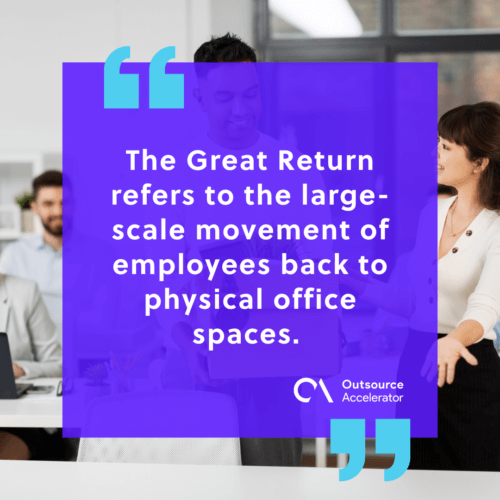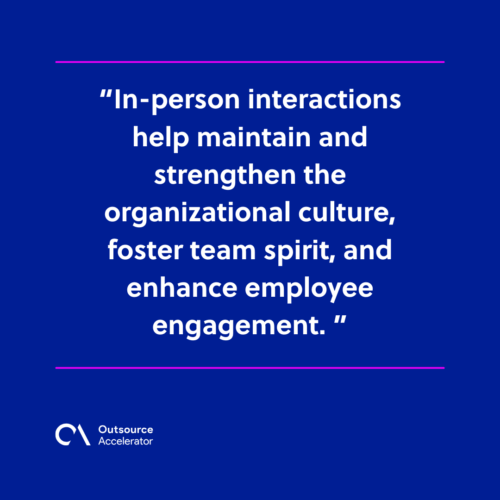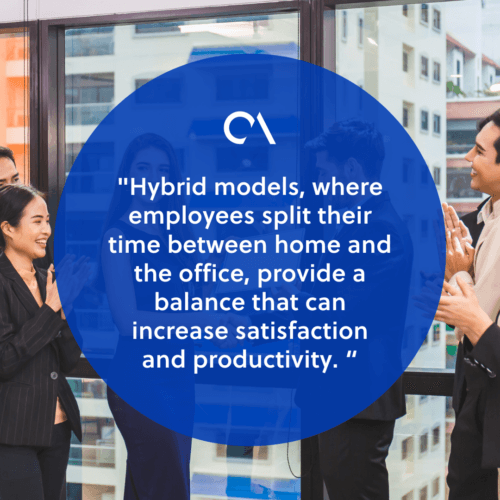The Great Return: Rethinking work-life balance in a changed world

As the world emerges from the grips of the COVID-19 pandemic, a new trend is taking shape in the corporate landscape – the Great Return to the office.
After months of remote work and virtual collaboration, businesses are now facing the complex challenge of bringing their employees back to the physical workplace.
This shift promises to reshape the way we work, presenting both opportunities and obstacles for organizations and their workforce alike.
In this article, we explore the multifaceted nature of the Great Return and the strategies being employed to navigate this pivotal moment in modern work culture.
What is the Great Return?
The Great Return refers to the large-scale movement of employees back to physical office spaces. It follows the extended period of remote work that was initiated by the COVID-19 pandemic.
Many factors incited the Great Return, including the easing of quarantine restrictions, increased vaccination rates, and a desire by companies to restore in-person collaboration.

It should be noted that this trend does not have a clear-cut positive reception. Many workers now prefer remote work and are dreading or resisting orders to return to the office.
Unsurprisingly, this is one of the factors that led to the Great Resignation.
When handled properly, the Great Return represents a pivotal moment in reshaping modern work dynamics. Companies must aim to balance the advantages of remote work with the traditional in-person office experience.
What prompted the Great Return?
The Great Return is a multifaceted transition driven by a combination of health, economic, social, and operational factors. It reflects the complexities of modern work environments and the diverse needs and preferences of the workforce.
Some of the primary factors that prompted the Great Return include:
Vaccination rollouts and easing of COVID-19 restrictions
One of the primary drivers of the Great Return is the widespread availability and administration of COVID-19 vaccines. Vaccination efforts have significantly reduced the risk of severe illness and transmission, making it safer to return to shared office spaces.
The increased confidence in public health measures has encouraged many to consider a return to in-person work as a viable option.
Economic recovery
As global economies rebound from the pandemic-induced downturn, businesses are looking to restore pre-pandemic operations.
The return to the office is seen as a critical component of economic recovery. The move enables companies to:
- Operate at full capacity
- Stimulate local economies
- Create jobs
Office-centric operations are particularly crucial for sectors that rely heavily on in-person interactions and physical presence, such as retail, hospitality, and manufacturing.
Desire for in-person collaboration and productivity
Many businesses recognize the value of face-to-face interaction for fostering creativity, innovation, and teamwork. Physical proximity allows for spontaneous brainstorming sessions, quicker decision-making, and more effective communication.
Organizational culture and identity
The workplace is more than just a place for your job. It’s a social environment where relationships are built and company culture is reinforced.
In-person interactions help maintain and strengthen the organizational culture, foster team spirit, and enhance employee engagement.

Technological limitations
While remote work technology has advanced significantly, it is not without its limitations. Some tasks and processes are more efficiently handled in person, especially those requiring specialized equipment, secure environments, or hands-on collaboration.
Additionally, many have experienced “Zoom fatigue” associated with constant virtual meetings. This has highlighted the need for more varied and dynamic forms of interaction that the office setting can provide.
Employee well-being and engagement
While many employees enjoy the flexibility of remote work, others prefer the structure and social interaction of the office environment.
For some, the separation of home and work life is essential for mental well-being and productivity. New employees or those early in their careers may seek the mentorship and networking opportunities that in-person work provides.
The Great Return aims to address these concerns by providing opportunities for social interaction, team building, and support.
How to manage the Great Return for your employees
Managing the Great Return for your employees involves careful planning, clear communication, and considerations for their well-being. By making the process as painless as possible, you can avoid the risk of another Great Regret.
Here are some tips to help you manage this return for your employees:
1. Develop a return-to-office plan
The Great Return should be an evolving process. Create a comprehensive plan outlining the phased approach to bringing employees back to the office.
Every employee’s situation is unique, and addressing individual concerns is crucial. Consider employee feedback when developing your plan to identify areas for improvement.
2. Communicate transparently
Effective management of the Great Return begins with clear and transparent communication. Provide employees with detailed information about the return-to-office plans, including timelines, health and safety measures, and expectations.
3. Offer flexibility
Recognize that employees have different comfort levels and circumstances. Offering flexible work options can ease the transition and accommodate diverse employee needs.
Hybrid models, where employees split their time between home and the office, provide a balance that can increase satisfaction and productivity.
Allowing employees to choose their in-office days or maintaining some remote work flexibility can help address individual preferences and circumstances.

4. Provide support and resources
Employees may need resources and training to adapt to the new work environment. This includes training on new health and safety protocols, as well as resources for hybrid work technologies and best practices.
Providing ergonomic equipment and mental health support can also help employees transition smoothly and maintain well-being.
5. Promote collaboration and team building
The return to the office is an opportunity to rebuild and strengthen team dynamics. Organizing team-building activities, social events, and collaborative projects can help re-establish connections and boost morale.
Encouraging face-to-face interactions, even in a hybrid model, can enhance teamwork and communication.
6. Ensure a safe and healthy workplace
Prioritizing health and safety is crucial to alleviate employees’ concerns about returning to the office.
You can implement the following measures to help create a safer work environment:
- Enhanced cleaning protocols
- Improved ventilation
- Social distancing arrangements
- Access to personal protective equipment (PPE)
- Encouraging or facilitating vaccinations
7. Lead by example
Leaders play a critical role in managing the Great Return. They should demonstrate empathy and understanding, acknowledging the challenges and anxieties employees may face.
Demonstrate your commitment to the Great Return by setting a positive example through your actions and communication.
Provide support through regular check-ins, open-door policies, and mental health resources to foster a supportive environment. You should also model desired behaviors, such as adhering to health protocols and embracing hybrid work arrangements.







 Independent
Independent




